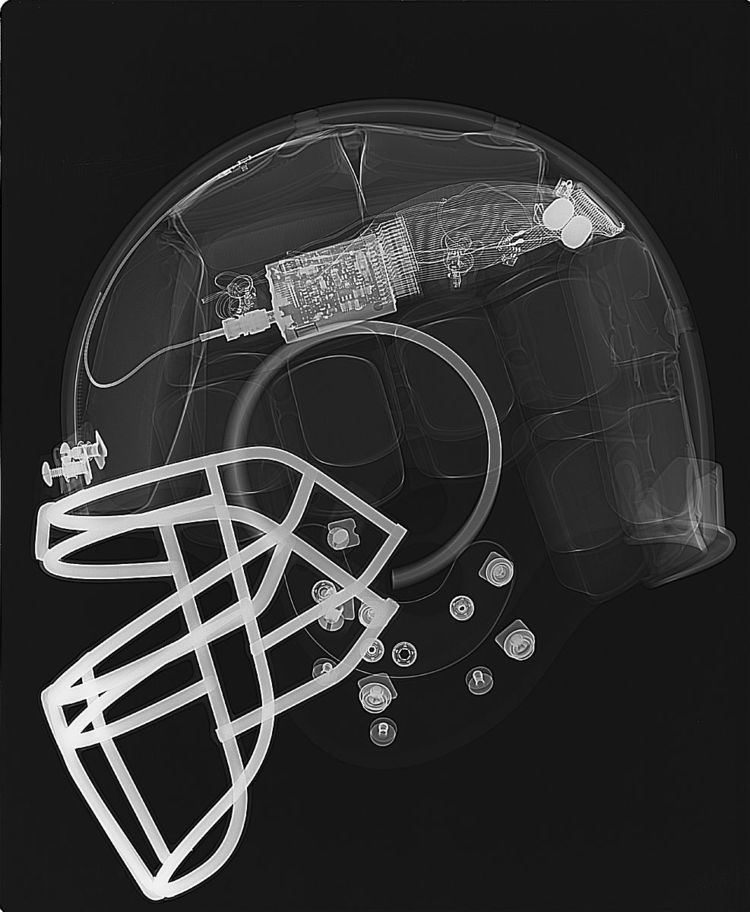 | ||
Head Impact Telemetry (HIT) System technology was developed by Simbex (Lebanon, NH) with support from the National Institutes of Health (NIH; R44HD40743 and R01HD048638) to measure and record in vivo head impact exposure (i.e. frequency, location, and kinematics of head impact). Since 2003, the core technology, which includes an array of non-orthogonal accelerometers, data acquisition, RF telemetry hardware, and post-processing software, has been used in a variety of sport and military applications to investigate the relationship between head kinematics and brain injury. This research has enabled and contributed to improved helmet design and testing methods, changes to sporting rules and regulations, and novel approaches to improve player safety. Additionally, HIT System technology is the essential feature of Riddell’s Sideline Response System (SRS) - a real-time monitoring tool used by American football teams to manage an athlete’s head impact exposure.
Contents
Technology
Head Impact Telemetry (HIT) System technology incorporates an array of non-orthogonal accelerometers (Analog Devices, Inc., Cambridge, MA), data acquisition (1000 Hz over 40 ms time window), and RF telemetry hardware into self-contained inserts placed in commercially available helmets. The broad technology has been tailored to multiple helmet models, including those for: American-style football, boxing, soccer, ice hockey, equestrian, snow sports, and several military applications. While physically connected to the helmet, the instrumented insert acts as an effective spring to maintain contact with the head during impact and to decouple head acceleration from helmet acceleration.
Data collection occurs when any of the six accelerometers exceeds a pre-filtered threshold (8 ms pre-trigger and 32 ms post-trigger). Data is then transmitted wirelessly to a laptop computer where each event is processed and stored within a relational database. Communication range of the system typically exceeds 200 yards; however, in the event of poor communication, each in-helmet sensor array is capable storing up to 100 impacts in nonvolatile memory to minimize the potential for data loss.
Traditional mathematical approaches to calculate head kinematics about the center of gravity (CG), such as those employed in controlled laboratory testing, require precise accelerometer mounting. Because this is not practical for field implementation, the HIT System uses a custom, simulated-annealing optimization algorithm to obtain linear and angular acceleration of the head CG from output of the six head mounted accelerometers. Impact location is then estimated by taking the reflection of the three-dimensional direction vector of peak linear acceleration. The directional vector is then converted to a spherical head coordinate system (azimuth and elevation).
To validate the technology for on-field acquisition of head impact exposure, a multi-phase verification process was conducted which included laboratory testing, video correlation of on-field events, and multi-site field trials.
Research Use and Outcomes
The first on-field use of the HIT System occurred during the 2003 football season at Virginia Tech. Since that time, usage has spread to all levels of play in football (i.e. Professional, College, High School, Youth) and been used to collect head impact exposure data in a wide variety of sporting and military environments. This has generated an exposure database that, as of 2017, includes more than 3.5 million recorded head impacts.
Funding from multiple sources, including the NIH (R01HD048638, R01NS094410, R01NS055020, R01NS092853, and R21NS088781), Centers for Disease Control and Prevention (R01CE001254 and 5R49CE000196), Department of Defense, NOCSAE, and Riddell, has enabled multi-institutional research initiatives to help clinicians, biomechanics, and investigators better understand the relationship between head impact exposure and concussion injury in sports.
Key outcomes from this work, which has involved multiple institutions (Dartmouth, Brown, Virginia Tech, Michigan, North Carolina, Purdue, U Pittsburgh Medical Center, Indiana, and others), include:
Information from these studies has been used as the basis for:
Commercial Use
The HIT System technology is an essential feature of the Riddell (Chicago, IL) Sideline Response System (SRS). The SRS is available for American-style football and is the only HIT System variant marketed commercially.
The Riddell SRS, which was first introduced in 2005, monitors and records head impact exposure during play and alerts sideline personnel that an atypical exposure has occurred. The SRS is not a medical or protective device and does not diagnose concussions or other head injuries. Its intended use is to improve the efficiency and effectiveness of all sideline staff and encourage the consistent application of appropriate sideline practices to identify and reduce head impact exposure.
The SRS software provides several real-time alert options as well as the ability to review and export head impact data retrospectively. Key single impact measures include peak linear and angular acceleration at the head center of gravity, contact location, and acceleration duration. Additionally, the system captures time of each impact, helmet temperature, and computes severity indices such as Head Impact Criteria (HIC), Gadd Severity Index (GSI), and Head Impact Telemetry Severity Profile (HITsp).
For real-time alerting, a local paging system informs sideline personnel of any impact exceeding an alarm threshold for available impact measures. Default alarm thresholds are provided for all impact measures; however, thresholds can be modified for individual players. Additionally, a custom Alerting Protocol is available that identifies players who have experienced atypically high head impact exposure for their skill level (i.e. Professional, College, High School, Youth) and playing position. Atypical exposure is defined for both single and cumulative impacts and derived from the millions of head impacts recorded with the SRS since 2005.
InSite - Next Generation HIE Monitoring
In 2013, Simbex and Riddell partnered to launch a second-generation head impact monitoring system – the InSite Impact Response System – that builds on the research foundations laid by SRS. With support from the National Institutes of Health (R44HD061224), InSite incorporates low power electronics and thin-film sensor technology to make the benefits of head impact exposure monitoring accessible to teams and leagues at all levels of the sport.
